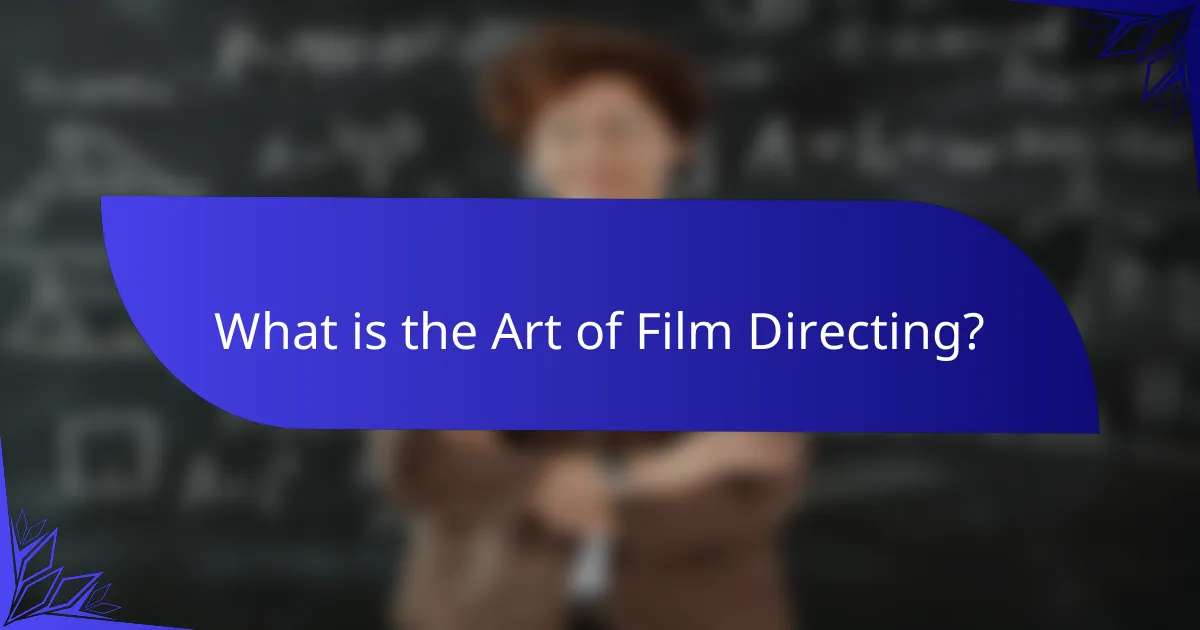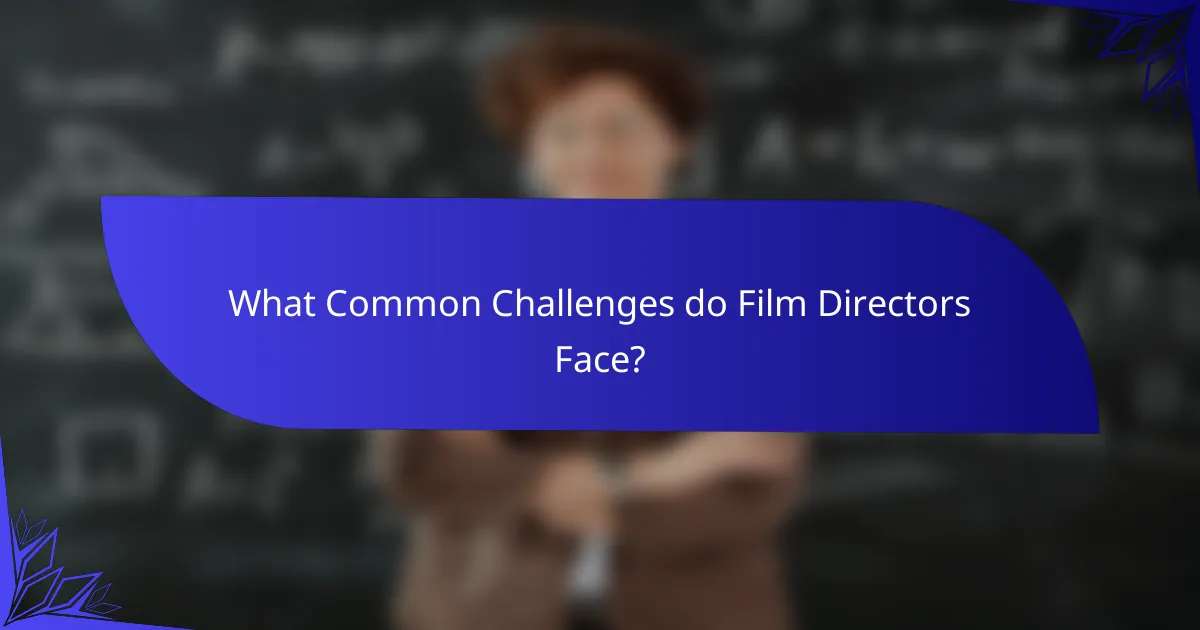Film directing is a multifaceted discipline that involves overseeing the creative and technical elements of a film to shape its narrative, performance, and visual style. Key techniques in film directing include script analysis, shot composition, and actor direction, all of which are essential for effective storytelling. Directors face challenges such as managing diverse teams, adhering to budget constraints, and navigating tight schedules, which require strong leadership and problem-solving skills. Creative approaches, including visual storytelling and non-linear narratives, can enhance the filmmaking process and resonate with audiences. Historical figures like Alfred Hitchcock and Martin Scorsese exemplify the impact of distinctive directorial styles on the film industry.

What is the Art of Film Directing?
The art of film directing involves guiding the creative and technical aspects of a film. Film directors shape the narrative, performance, and visual style. They collaborate with actors, cinematographers, and other crew members. Directors interpret the script and develop a vision for the film. They make decisions on casting, location, and shot composition. The role requires strong leadership and communication skills. Successful directors have a deep understanding of storytelling, pacing, and audience engagement. Historical examples include Alfred Hitchcock and Martin Scorsese, known for their distinctive styles and impactful films.
How does film directing differ from other filmmaking roles?
Film directing differs from other filmmaking roles by focusing on the overall vision and execution of a film. The director is responsible for interpreting the script and guiding the creative aspects of the production. This includes working with actors, cinematographers, and production designers to achieve the desired aesthetic and emotional impact. Unlike roles such as editing or sound design, which concentrate on specific technical tasks, directing encompasses the entire storytelling process. Directors make crucial decisions about casting, shot composition, and pacing. They also collaborate closely with the writers to ensure the narrative aligns with their vision. This leadership role is essential in shaping the film’s artistic direction and coherence.
What are the primary responsibilities of a film director?
A film director is responsible for overseeing the creative aspects of a film. This includes interpreting the script and developing a vision for the film’s overall style. Directors guide actors in their performances to achieve the desired emotional impact. They collaborate with the production team to ensure that the visual and auditory elements align with their vision. Directors make decisions on casting, locations, and set designs. They also work closely with the cinematographer to determine shot composition and lighting. Additionally, directors are involved in the editing process to finalize the film’s pacing and structure. Their leadership is crucial in uniting the various departments to create a cohesive final product.
How does a director’s vision shape a film?
A director’s vision fundamentally shapes a film by guiding its narrative, visual style, and emotional tone. This vision determines how the story is told and experienced by the audience. For example, a director may choose a specific genre, which influences the film’s pacing and structure. The director’s choices in casting and performance style also reflect their vision, impacting character development and audience connection.
Moreover, the visual composition, including shot selection and color palette, is dictated by the director’s artistic intent. This can create a distinct atmosphere that resonates with viewers. Additionally, the director collaborates with cinematographers, editors, and production designers to ensure that every element aligns with their vision.
Historical examples, such as Alfred Hitchcock’s suspenseful storytelling in films like “Psycho,” showcase how a director’s vision can create a lasting impact on cinematic language. Similarly, Quentin Tarantino’s unique dialogue and nonlinear narratives are direct manifestations of his creative vision. These elements collectively form a cohesive film that communicates the director’s intended message and emotional experience.
Why is mastering film directing essential for filmmakers?
Mastering film directing is essential for filmmakers because it enables them to effectively communicate their vision. A skilled director shapes the narrative, guiding actors and crew to achieve a cohesive story. This mastery enhances the overall quality of the film, influencing audience engagement. According to a study by the University of Southern California, directors with strong skills significantly improve film ratings. Strong directing skills also foster collaboration, ensuring that all creative elements align. This alignment leads to a more polished final product, crucial in a competitive industry. Ultimately, mastering film directing is vital for artistic expression and commercial success.
What skills are necessary for effective film directing?
Effective film directing requires strong leadership, communication, and creative vision. Leadership skills help directors guide cast and crew toward a shared artistic goal. Communication skills ensure that ideas are conveyed clearly to everyone involved in the production. Creative vision allows directors to conceptualize the film’s style, tone, and narrative.
Additionally, problem-solving skills are essential for overcoming challenges during production. Time management is crucial to keep the project on schedule and within budget. Understanding technical aspects of filmmaking, such as camera work and editing, enhances a director’s effectiveness.
Collaboration with writers, producers, and actors fosters a productive environment. These skills collectively contribute to a director’s ability to create compelling films.
How does mastering directing impact a film’s success?
Mastering directing significantly enhances a film’s success. A skilled director shapes the narrative, guiding actors and crew effectively. This cohesive vision leads to a more engaging story. Strong direction improves pacing and emotional impact, resonating with audiences. According to a study by the University of Southern California, films with well-directed scenes receive higher ratings from critics and viewers. Directors like Steven Spielberg have demonstrated that mastery in directing correlates with box office success and critical acclaim. Overall, effective directing is crucial for translating a script into a compelling visual experience.

What are the Essential Techniques in Film Directing?
Essential techniques in film directing include script analysis, shot composition, and actor direction. Script analysis involves understanding the narrative structure and character arcs. This technique ensures the director can convey the story effectively. Shot composition refers to framing scenes to enhance visual storytelling. It includes the use of angles, lighting, and movement. Effective shot composition can significantly impact audience engagement. Actor direction focuses on guiding performances to achieve desired emotional responses. This technique requires clear communication and an understanding of character motivations. Each of these techniques is vital for creating a cohesive and compelling film.
How do directors approach script analysis?
Directors approach script analysis by breaking down the script into its fundamental elements. They identify character arcs, themes, and plot structure. This process helps them understand the story’s emotional core. Directors often create notes on each character’s motivations and relationships. They analyze dialogue to capture the tone and subtext. Visualizing scenes through storyboards is a common technique. This aids in planning the visual storytelling. Additionally, directors may collaborate with actors during this phase to gain insights. This collaborative analysis enhances the overall interpretation of the script.
What key elements do directors look for in a script?
Directors look for compelling characters, engaging dialogue, and a strong narrative structure in a script. Compelling characters drive the story and connect with the audience. Engaging dialogue reveals character traits and advances the plot. A strong narrative structure provides a clear beginning, middle, and end. Additionally, originality and thematic depth are crucial. Originality ensures the script stands out in a competitive industry. Thematic depth allows for exploration of complex ideas, enhancing audience engagement. Directors also consider pacing and visual storytelling potential. Pacing affects the script’s rhythm and overall impact. Visual storytelling potential indicates how well the script translates to film. These elements collectively contribute to a script’s effectiveness in film production.
How can script analysis influence casting decisions?
Script analysis can significantly influence casting decisions by identifying character traits and narrative arcs. Analyzing the script reveals the emotional depth required for each role. This helps casting directors match actors with the necessary skills and experience. For instance, a character requiring vulnerability may be better suited to an actor known for their dramatic performances. Additionally, script analysis highlights the chemistry needed between characters. This understanding can guide casting choices to ensure compatibility among actors. Ultimately, informed casting decisions lead to a more cohesive and believable performance.
What role does visual storytelling play in film directing?
Visual storytelling is crucial in film directing as it conveys emotions and narratives without relying solely on dialogue. Directors utilize visual elements like composition, color, and movement to enhance storytelling. For example, a close-up can evoke intimacy, while wide shots may establish context. The use of visual metaphors can also deepen thematic resonance. Historical films, like “Schindler’s List,” demonstrate how visual storytelling can powerfully depict complex subjects. Effective visual storytelling can engage audiences and create memorable cinematic experiences.
How do directors use cinematography to enhance storytelling?
Directors use cinematography to enhance storytelling by visually representing themes and emotions. They employ camera angles to convey perspective. Low angles can portray power, while high angles suggest vulnerability. Lighting choices create mood and atmosphere. For instance, harsh lighting can evoke tension, while soft lighting may indicate warmth. Color palettes also play a crucial role. Specific colors can symbolize emotions or themes, such as red for passion or danger. Movement in shots, like tracking or panning, can build excitement or suspense. Composition guides the viewer’s focus and influences interpretation. Directors strategically frame shots to highlight important elements. These techniques collectively strengthen narrative impact and viewer engagement.
What techniques can directors employ to create mood and atmosphere?
Directors can employ various techniques to create mood and atmosphere in film. Lighting is a crucial element; it sets the tone and influences the audience’s emotions. For instance, low-key lighting can evoke suspense or fear, while bright lighting can create a cheerful or uplifting mood. Sound design also plays a significant role; background music or ambient sounds can enhance emotional responses. Color palettes further contribute; warm colors may suggest comfort, while cool colors can create a sense of distance or sadness. Camera angles and movements can influence perception; a close-up can heighten intimacy, while a wide shot may convey isolation. Additionally, pacing and editing rhythms can affect tension and release, guiding audience reactions. Each of these techniques, when used thoughtfully, helps to immerse viewers in the film’s emotional landscape.

What Creative Approaches can Directors Utilize?
Directors can utilize various creative approaches to enhance storytelling. One approach is visual storytelling, which uses imagery to convey emotions and themes. Another method is improvisation, allowing actors to bring authenticity to their performances. Directors may also employ non-linear narratives, which challenge traditional storytelling structures. Collaborating with diverse teams can introduce fresh perspectives and ideas. Additionally, integrating multimedia elements can create immersive experiences for the audience. Directors often draw inspiration from different art forms, such as theater or painting, to influence their style. These approaches can lead to innovative and impactful films that resonate with viewers.
How can directors foster collaboration with their crew?
Directors can foster collaboration with their crew by establishing clear communication channels. Regular meetings promote transparency and ensure everyone is on the same page. Encouraging feedback allows crew members to voice their ideas and concerns. Directors should also create a supportive environment that values each member’s contributions. Utilizing collaborative tools can streamline workflow and enhance teamwork. Building trust is essential; directors should show appreciation for hard work. When crew members feel valued, they are more likely to collaborate effectively. Studies show that effective communication and trust significantly improve team dynamics in film production.
What strategies can enhance communication on set?
Establishing clear communication protocols enhances communication on set. This can include regular briefings before shooting begins. Daily meetings help ensure everyone understands their roles and responsibilities. Using visual aids, like call sheets and diagrams, clarifies complex scenes. Designating a communication lead can streamline information flow. Implementing a feedback loop allows for real-time adjustments during filming. Utilizing technology, such as walkie-talkies or communication apps, keeps the team connected. These strategies foster a collaborative environment, ultimately improving production efficiency.
How does collaboration influence creative outcomes?
Collaboration enhances creative outcomes by combining diverse perspectives. This synergy fosters innovative ideas that may not emerge in isolation. Studies show that teams with varied backgrounds generate more unique solutions. For example, a 2018 research by the Harvard Business Review found that diverse teams outperform homogenous ones in problem-solving. Additionally, collaboration encourages constructive feedback, refining concepts further. Creative partnerships often lead to unexpected breakthroughs, enriching the final product. The interplay of different skills and experiences drives creativity in filmmaking. Ultimately, collaboration is crucial for maximizing artistic potential.
What innovative methods can directors apply to storytelling?
Directors can apply innovative methods to storytelling by utilizing non-linear narratives. This approach allows for a more complex and engaging plot structure. They can also incorporate interactive elements, enabling audience participation in the story. Virtual reality technology can immerse viewers in the narrative, creating a unique experience. Additionally, directors can blend different genres to challenge conventional storytelling. Experimenting with visual storytelling techniques, like animation or mixed media, can enhance narrative depth. Furthermore, using real-time feedback from audiences can shape the direction of the story. These methods can lead to more dynamic and memorable cinematic experiences.
How can directors use non-linear narratives effectively?
Directors can use non-linear narratives effectively by structuring the story to enhance emotional impact. This approach allows for a complex exploration of themes and character development. Flashbacks and flash-forwards can create suspense and intrigue. By revealing information out of chronological order, directors can engage the audience’s curiosity. This technique encourages viewers to piece together the narrative themselves. Films like “Pulp Fiction” and “Memento” demonstrate this effectiveness. They successfully captivate audiences through their innovative storytelling methods. Using non-linear narratives can also highlight character motivations and conflicts more vividly.
What are the benefits of integrating technology in film directing?
Integrating technology in film directing enhances efficiency and creativity. It allows for advanced visual effects, improving storytelling. Directors can utilize digital editing tools for precise control over scenes. Technology enables real-time feedback during filming, fostering collaboration. Virtual reality can create immersive environments for actors. Additionally, data analytics can inform audience preferences, guiding creative decisions. Overall, technology streamlines production processes and expands artistic possibilities.

What Common Challenges do Film Directors Face?
Film directors face numerous common challenges throughout the filmmaking process. One significant challenge is managing a diverse team. Directors must coordinate actors, crew members, and production staff, each with unique needs and perspectives. Budget constraints often limit creative options. Directors must balance artistic vision with financial realities. Time management is another critical issue. Tight schedules can lead to rushed decisions and compromised quality. Creative differences can also arise among team members. Directors need to navigate conflicts to maintain a cohesive vision. Technical challenges, such as equipment failures or location issues, can disrupt production. Directors must be adaptable and problem-solving. Finally, audience expectations can create pressure. Directors aim to satisfy both critics and viewers while staying true to their vision.
How can directors manage budget constraints?
Directors can manage budget constraints by prioritizing essential elements of production. They should create a detailed budget plan that outlines all necessary expenses. This plan helps identify areas where costs can be reduced. Collaborating with department heads can lead to innovative solutions that save money. Utilizing local resources and talent can also minimize expenses. Additionally, directors can consider alternative funding sources, such as crowdfunding. Effective communication with producers ensures alignment on budgetary goals. Historical data shows that films with strict budget management often achieve higher profitability. For instance, “The Blair Witch Project” was produced on a budget of $60,000 and grossed nearly $250 million.
What strategies can help directors maximize resources?
Directors can maximize resources by implementing efficient planning and budgeting strategies. Effective pre-production planning ensures that all aspects of the film are organized. This includes creating detailed shooting schedules and shot lists. Budgeting accurately helps allocate funds to necessary areas, minimizing waste. Utilizing technology, such as project management software, can streamline communication and task management. Directors should also prioritize collaboration with their team to leverage diverse skills and perspectives. Additionally, scouting locations in advance can reduce costs and time on set. Lastly, fostering relationships with vendors can lead to better deals and resource availability.
How can directors negotiate with producers effectively?
Directors can negotiate with producers effectively by establishing clear communication and understanding each party’s goals. Directors should prepare a detailed vision for the project. This includes a budget, timeline, and creative direction. Presenting this information helps build credibility. Listening to producers’ concerns is also crucial. It fosters collaboration and shows respect for their expertise.
Using data to support requests can strengthen a director’s position. For example, citing successful films with similar budgets can provide context. Building rapport through regular updates can maintain a positive relationship. Additionally, being flexible and open to compromise can lead to mutually beneficial agreements.
Successful negotiations often result in a shared commitment to the project’s vision. This approach enhances the likelihood of a smooth production process.
What are the challenges of working with actors?
Working with actors presents several challenges. One challenge is managing diverse personalities. Actors often have varying levels of experience and emotional needs. Another challenge is ensuring effective communication. Directors must convey their vision clearly while being receptive to actors’ interpretations. Additionally, scheduling conflicts can arise. Actors may have other commitments that complicate production timelines. Furthermore, emotional vulnerability is a significant aspect. Actors may need to access deep emotions, which can be taxing. Lastly, navigating creative differences is common. Directors and actors may have differing views on character portrayal. These challenges require strong leadership and adaptability from directors.
How can directors build trust and rapport with their cast?
Directors can build trust and rapport with their cast by fostering open communication. This involves actively listening to actors’ concerns and ideas. Creating a safe environment encourages vulnerability. Directors should also provide constructive feedback, which helps actors grow. Regular team-building activities can enhance relationships. Transparency about the project vision builds shared understanding. Respecting actors’ creative processes fosters mutual respect. Trust is strengthened through consistent support and encouragement.
What techniques can help directors elicit strong performances?
Directors can elicit strong performances by employing various techniques. One effective method is creating a safe and collaborative environment. This allows actors to explore their characters freely. Another technique is providing clear direction and feedback. This helps actors understand the vision and their role within it. Additionally, using improvisation can unlock authentic emotions. It encourages actors to step outside their comfort zones.
Building strong relationships with actors is also crucial. Trust fosters better communication and performance. Directors can also utilize rehearsals to refine performances. This practice allows actors to experiment and develop their characters. Finally, studying successful performances in film history can inspire directors. Analyzing what worked well in those cases provides valuable insights.
What Practical Tips can Enhance Your Directing Skills?
To enhance your directing skills, focus on effective communication. Clear communication fosters collaboration among cast and crew. Practice active listening to understand different perspectives. Study films critically to analyze directing styles and techniques. Engage in workshops to gain hands-on experience. Collaborate with other filmmakers to learn from their approaches. Seek feedback on your work to identify areas for improvement. Lastly, stay adaptable to changes during production, as flexibility can lead to creative solutions.
How can aspiring directors gain experience and knowledge?
Aspiring directors can gain experience and knowledge through practical involvement in film projects. They should seek opportunities to assist established directors on set. Working in various roles, such as production assistant or script supervisor, provides valuable insights. Participating in film schools or workshops enhances technical skills and networking. Engaging in community theater or short film projects allows for hands-on practice. Additionally, studying classic and contemporary films sharpens analytical skills. Reading books on directing and filmmaking offers theoretical knowledge. Following industry trends and attending film festivals expands understanding of the market.
What resources are available for continuous learning in film directing?
Online courses from platforms like MasterClass and Coursera provide structured learning in film directing. These courses often feature renowned directors sharing their insights and techniques. Books on film directing, such as “Directing: Film Techniques and Aesthetics” by Michael Rabiger, offer in-depth knowledge and practical advice. Film schools and workshops, like those offered by the American Film Institute, provide hands-on experience and mentorship opportunities. Additionally, industry seminars and conferences, including the Sundance Film Festival, facilitate networking and learning from industry professionals. Resources like podcasts and YouTube channels also offer valuable tips and discussions on directing.
The main entity of the article is film directing, which encompasses the creative and technical guidance of a film’s production. The article explores essential techniques such as script analysis, shot composition, and actor direction, highlighting how these elements contribute to effective storytelling. It also discusses creative approaches directors can utilize, including non-linear narratives and collaboration with diverse teams, while addressing common challenges like budget constraints and managing actor dynamics. Furthermore, the article provides practical tips for aspiring directors to enhance their skills and gain experience in the industry.